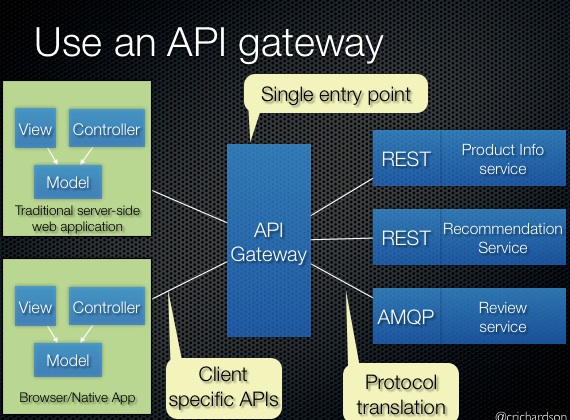API Gateway
Fleeting- External reference: https://www.redhat.com/fr/topics/api/what-does-an-api-gateway-do
- External reference: https://microservices.io/patterns/apigateway.html
- External reference: https://www.akana.com/blog/api-proxy-vs-api-gateway
- External reference: https://www.akana.com/blog/what-is-an-api-gateway
API gateway
API gateway that is the single entry point for all clients. The API gateway handles requests in one of two ways. Some requests are simply proxied/routed to the appropriate service. It handles other requests by fanning out to multiple services.
Une passerelle d’API est un outil de gestion des interfaces de programmation d’application (API) qui se positionne entre un client et une collection de services back-end
— https://www.redhat.com/fr/topics/api/what-does-an-api-gateway-do
agit comme un proxy inversé qui accepte tous les appels des API, rassemble les différents services requis pour y répondre et renvoie le résultat approprié
— https://www.redhat.com/fr/topics/api/what-does-an-api-gateway-do
The granularity of APIs provided by microservices is often different than what a client needs. Microservices typically provide fine-grained APIs, which means that clients need to interact with multiple services. […] API gateway that is the single entry point for all clients.
An API proxy is the interface that developers use to access your backend services
it sits between your application and backend services. Essentially, it’s a thin API server
API proxy is basically a lightweight API gateway. It includes some basic security and monitoring capabilities. So, if you already have an API and your needs are simple, an API proxy will work fine.
gateway, of course, still offers the same capabilities that an API proxy would offer for security and monitoring
API gateway is a component of API management. An API gateway sits between backend services and a client (requester) to transmit requests and responses. An API gateway receives calls, aggregates services to fulfill them, and returns a result.
provides a unified entry point across internal APIs
control user access
security measures, like rate limiting, and applies security policies, like OAuth or JWT.
Rather than provide a one-size-fits-all style API, the API gateway can expose a different API for each client
backend for frontend
A variation of the API Gateway pattern.
variation of this pattern is the Backends for frontends pattern. It defines a separate API gateway for each kind of client
Notes linking here
- api gateway serve request using priority
- API Gateway vs Backend For Frontend
- API proxy vs. API gateway
- difference between api gateway and reverse proxy
- hoot about proxies, ingress and API gateways
- how do I create an OAuth 2.0/OIDC resource server? (blog)
- ingress vs api gateway
- KrakenD
- use an API Gateway
